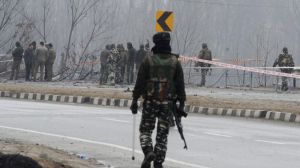Market capitalisation drops by Rs 1,25,000 crore in 6 months
MUMBAI, Oct 18: While the deafening sound of crackers has started livening up the festive spirit, the mood is sullen among millions of in...

MUMBAI, Oct 18: While the deafening sound of crackers has started livening up the festive spirit, the mood is sullen among millions of investors across the country. With the erosion in share prices upsetting their calculations, there is no excitement on Dalal Street — where the Bombay Stock Exchange is located — about this year’s Diwali festival.
Even as investors and punters prepare themselves for ushering in new Samvat 2055, most of them are counting their losses suffered in the just ended Samvat 2054. The market capitalisation (i.e. total market value of around 6,900 scrips listed on the stock exchange) has crashed from Rs 5,80,000 crore in April this year to Rs 4,55,000 crore last Friday. This means investors have made a notional loss of nearly Rs 1,25,000 crore in just six months.
The rot has spread across the board. While thousands of dud shares — floated in the public issue boom during the 1994-96 period but quoting at abysmal levels of Rs five and below — were the bane of investors so far,even top-notch shares like Telco, SBI, Reliance and IDBI have now crashed on the market. Several shares like Tata Steel, Telco, Bombay Dyeing, Tata Chemicals and Larsen & Toubro — which constitute the Sensex (30-scrip Sensitive Index) — are quoting at their 52-week low levels.
The market cap of several leading shares have also crashed. Telco’s market cap plunged from Rs 9,088 crore to Rs 2,636 crore within a year. SBI’s market cap fell from Rs 16,200 crore to Rs 8,263 crore, IDBI from Rs 7,908 crore to Rs 2,581 crore and Reliance from Rs 20,783 crore to Rs 9,870 crore. “The market value of the investments has eroded drastically. There is a severe crisis of confidence,” said a former president of the BSE, indicating that PSU disinvestment will be affected by the market crisis.
“I’ve lost interest. Things are going from bad to worse,” said broker Pawan Dharnidharka, who is even planning to skip the auspicious `Moorat’ trading session (when token purchases are made for ushering in new year).Anticipating a poor response, BSE has also curtailed the `Moorat’ session from two hours to one hour on Monday.
It was a good going till April when Sensex touched an average of 4115. Foreign institutional investors were net buyers of Indian shares and retail investors started trooping back. By that time, the political uncertainty which gripped the entire market had also started disappearing. Come May and the nuclear explosions sent the market into a tailspin.
While FIIs pulled out over US $ 550 million (around Rs 2,310 crore) from the Indian markets, local investors also joined the sellers bandwagon. Sanctions imposed by the US and downgrading by rating agencies acted as catalysts for the downfall.
The developments at the Unit Trust of India’s (UTI) US-64 scheme has further exacerbated the parlous situation. Last Friday, saw the Sensex plunge to 2848. Financial institutions with big investments in stock markets were the major losers. Following the US-64 fiasco, punters are skeptical as to whether theUTI will be capable of moving the markets as earlier.
The redemption pressure on US-64 — which incidentally has more number of investors than in stocks — was a double blow for the investors. Result: even big and diversified companies with huge capital base have plunged to five-year lows. Telco which was the pride of Dalal Street bulls is one share which is quoting at such levels.
The fall in market cap would have been worst had software and pharmaceutical companies not gained ground. Newcomers like Infosys, Satyam, Pentafour and NIIT surged ahead and scored spectacular gains. But investors are not impressed. IDBI’s scrip which floated a public issue at Rs 130 per share two years ago is now languishing at Rs 38.
This is the case with most shares in the prestigious A group of the BSE. Punters are not hopeful of any dramatic recovery at least in the next six months. As an NSE dealer put it, “I don’t see any hope in the new Samvat. The Asian crisis is still continuing, UTI problems are yet to be sortedout, political uncertainty and sanctions are still there and new reforms are yet to be taken up.” The litany of woes continues.
A survey conducted by the Confederation of Indian Industry on the eve of Diwali has revealed that business confidence has plunged to a two-year low with a majority predicting a worsening of the current situation or a continuation of the same subdued business scenario. It is going to be a festival of darkness for the investing public. The million dollar question is: Once-bitten-twice-shy, will investors come back?
Photos





- 01
- 02
- 03
- 04
- 05


























